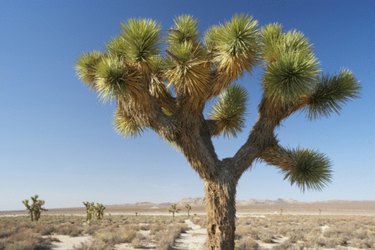
Plant leaves have tiny pores called stomata that absorb carbon dioxide from the air and release oxygen and evaporated water. This loss of water by evaporation is called transpiration. Most desert leaves have evolved special sizes, shapes, surfaces, colors and other characteristics to keep transpiration at a minimum. In some cases leaves of desert plants even store water.
Hairy Leaves
Video of the Day
Hairy leaves reflect the sunlight and block the movement of air. Both of these defenses help reduce the loss of water through transpiration. One example is the desert ironwood (Olneya tesota), also called Palo-de-Hierro, that has hairy blue-gray leaves and grows 15 to 25 feet tall. Another is the brittle bush (Encelia fannosa), which has leaves covered with a thick mat of tiny hairs that make the pale green leaves look gray-green.
Video of the Day
Narrow, Pointed Leaves
Some plants have narrow, sharp and pointed leaves. The smaller surface area makes it harder for the leaf to lose water through transpiration. A good example of this are the pointed leaves of the joshua tree, a species of yucca and a member of the lily family of plants (Liliaceae).
Special Stomata
Some desert plants leaves have a limited number of stomata, which cuts down on the amount of evaporated water that can escape. Other desert plants have stomata that open only at night when it is cooler and the risk of losing water through transpiration is lower. The leaves of the jade plant (Crassula ovata), a succulent native to arid regions of South Africa, have stomata that shut down during the day.
Waxy Surface
Leaves covered with special oils or waxes cut down on transpiration through stomata. The creosote bush (Larrea tridentata), which is common in the deserts of the American southwest, has these kinds of leaves.
Small Leaves
Tiny leaves have less surface and therefore fewer stomata to lose water from transpiration. These small leaves often flutter in the breeze, helping keep the plant cool and reducing the loss of water through the air. The littleleaf palo verde tree (Cercidium microphyllum) is one example of a tree using this kind of transpiration..
Thick Leaves
Succulents, including aloe and cacti, have thick leaves that store moisture in special plant cells called vacuoles. The stored moisture helps the plants survive long periods without rainfall. The agave plant (Agave Americana) is one example of a succulent that survives this way.
Light Color
Dark color absorbs more heat, adding to transpiration from the leaves. Light colored leaves reflect light and cut down on transpiration. For example, the leaves of sagebrush (Artemisia tridentata) and other desert plants are often a light green or grey color rather than dark green.
Leaves that Move
The leaves of some desert plants move throughout the day so sun hits only the edges of leaves thus keeping transpiration at a minimum. The leaves of the jojoba (Simmondsia chinensis), a shrub native to the Mojave and Sonoran deserts of Arizona, use this evolutionary strategy to survive the heat.
Absent Leaves
Cacti and some other desert plants have avoided transpiration from leaves by replacing them with spines or thorns. These plants conduct photosynthesis through the green exterior of their stems.